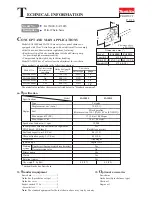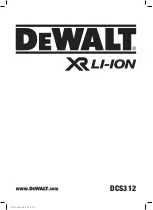
4
5
preventive safety measures reduce the risk of
starting the power tool accidentally.
• Store idle power tools out of the reach of chil-
dren and do not allow persons unfamiliar with
the power tool or these instructions to operate
the power tool.
Power tools are dangerous in the
hands of untrained users.
• Maintain power tools. Check for misalignment
or binding of moving parts, breakage of parts
and any other condition that may affect the
power tool’s operation. If damaged, have the
power tool repaired before use.
Many accidents
are caused by poorly maintained power tools.
• Keep cutting tools sharp and clean.
Properly
maintained cutting tools with sharp cutting edges
are less likely to bind and are easier to control.
• Use the power tool, accessories and tool bits
etc., in accordance with these instructions,
taking into account the working conditions
and the work to be performed.
Use of the power
tool for operations different from those intended
could result in a hazardous situation.
BATTERY TOOL USE AND CARE
SERVICE
• Have your power tool serviced by a qualifi ed
repair person using only identical replacement
parts.
This will ensure that the safety of the power
tool is maintained.
• Recharge only with the charger specifi ed by
the manufacturer.
A charger that is suitable for
one type of battery pack may create a risk of fi re
when used with another battery pack.
• Use power tools only with specifi cally desig-
nated battery packs.
Use of any other battery
packs may create a risk of injury and fi re.
• When battery pack is not in use, keep it away
from other metal objects like paper clips,
coins, keys, nails, screws, or other small metal
objects that can make a connection from one
terminal to another.
Shorting the battery termi-
nals together may cause burns or a fi re.
• Under abusive conditions, liquid may be eject-
ed from the battery, avoid contact. If contact
accidentally occurs, fl ush with water. If liquid
contacts eyes, additionally seek medical help.
Liquid ejected from the battery may cause irrita-
tion or burns.
SPECIFIC SAFETY RULES
1.
DANGER!:
Keep hands away from cutting area and
blade. Keep your second hand on auxiliary
handle or motor housing.
If both hands are
holding the saw, they cannot be cut by the
blade.
Do not reach underneath the workpiece.
The
guard cannot protect you from the blade below
the workpiece.
Adjust the cutting depth to the thickness
of the workpiece.
Less than a full tooth of the
blade teeth should be visible below the work-
piece.
NEVER hold piece being cut in your hands
or across your leg. Secure the workpiece to
a stable platform.
It is important to support the
work properly to minimize body exposure, blade
binding, or loss of control.
Hold power tool by insulated gripping sur-
faces when performing an operation where
the cutting tool may contact hidden wiring
or its own cord.
Contact with a “live” wire will
also make exposed metal parts of the tool “live”
and shock the operator.
When ripping always use a rip fence or
straight edge guide.
This improves the ac-
curacy of cut and reduces the chance of blade
binding.
Always use blades with correct size and
shape (diamond versus round) of arbor
holes.
Blades that do not match the mounting
hardware of the saw will run eccentrically, caus-
ing loss of control.
Never use damaged or incorrect blade wash-
ers or bolts.
The blade washers and bolts were
specially designed for your saw, for optimum
performance and safety of operation.
2.
Causes and Operator Prevention of KICK-
BACK:
KICKBACK is a sudden reaction to a pinched,
bound or misaligned saw blade, causing an un-
controlled saw to lift up and out of the workpiece
toward the operator.
When the blade is pinched or bound tightly
by the kerf closing down, the blade stalls and
the motor reaction drives the unit rapidly back
toward the operator.
If the blade becomes twisted or misaligned in
the cut, the teeth at the back edge of the blade
can dig into the top surface of the wood causing
the blade to climb out of the kerf and jump back
toward operator.
KICKBACK is the result of saw misuse and/or
incorrect operating procedures or conditions and
can be avoided by taking proper precautions as
given below:
Maintain
a
fi rm grip with both hands on the
saw and position your arms to resist kick-
back forces.
Position your body to either side
of the blade, but not in line with the blade. Kick-
back could cause the saw to jumb backwards,
but kickback forces can be controlled by the
operator, if proper precautions are taken.
When blade is binding, or when interrupting
a cut for any reason, release the trigger and
hold the saw motionless in the material until
the blade comes to a complete stop. Never
attempt to remove the saw from the work or
pull the saw backward while the blade is in
motion or kickback may occur.
Investigate
and take corrective actions to eliminate the
cause of blade binding.
When restarting a saw in the workpiece, cen-
ter the saw blade in the kerf and check that
saw teeth are not engaged into the material.
If
saw blade is binding, it may walk up or kickback
from the workpiece as the saw is restarted.
Support large panels to minimize the risk of
blade pinching and kickback.
Large panels
tend to sag under their own weight. Supports
must be placed under the panel on both sides,
near the line of cut and near the edge of the
panel.
Do not use dull or damaged blade.
Unsharp-
ened or improperly set blades produce narrow
kerf causing excessive friction, blade binding
and kickback.
Blade depth and bevel adjusting locking le-
vers must be tight and secure before making
cut.
If blade adjustment shifts while cutting, it
may cause binding and kickback.
Use extra caution when making a "plunge
cut" (or pocket cut) into existing walls or
other blind areas.
The protruding blade may
cut objects that can cause kickback.
3.
Check lower guard for proper closing before
each use. Do not operate saw if lower guard
does not move freely and close instantly.
Never clamp or tie the lower guard into the
open position.
If saw is accidentally dropped,
lower guard may be bent. Raise the lower guard
with the lower guard lever and make sure it
moves freely and does not touch the blade or
any other part, in all angles and depths of cut.
Check the operation of the lower guard
spring. If the guard and the spring are not
operating properly, they must be serviced
before use.
Lower guard may operate slug-
gishly due to damaged parts, gummy deposits,
or a buildup of debris.
Lower guard should be retracted manually
only for special cuts such as "plunge cuts"
("pocket cuts") and "compound cuts". Raise
lower guard by lower guard lever and as
soon as blade enters the material, the lower
guard must be released.
For all other sawing,
the lower guard should operate automatically.
Always observe that the lower guard is
covering the blade before placing saw down
on bench or fl oor.
An unprotected, coasting
blade will cause the saw to walk backwards,
cutting whatever is in its path. Be aware of the
time it takes for the blade to stop after switch is
released.
4.
Maintain labels and nameplates.
These carry
important information. If unreadable or missing,
contact a
MILWAUKEE
service facility for a free
replacement.
5.
WARNING:
Some dust created by power
sanding, sawing, grinding, drilling, and other
construction activities contains chemicals known
to cause cancer, birth defects or other reproduc-
tive harm. Some examples of these chemicals
are:
• lead from lead-based paint
• crystalline silica from bricks and cement and
other masonry products, and
• arsenic and chromium from chemically-treated
lumber.
Your risk from these exposures varies, depend-
ing on how often you do this type of work. To
reduce your exposure to these chemicals:
work in a well ventilated area, and work with
approved safety equipment, such as those dust
masks that are specially designed to fi lter out
microscopic particles.
Symbology
Direct Current
No Load Revolutions per
Minute (RPM)
Underwriters Laboratories, Inc.
United States and Canada




































